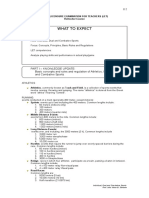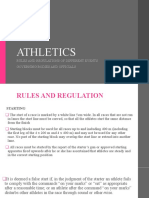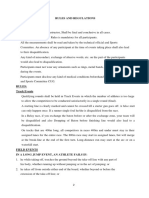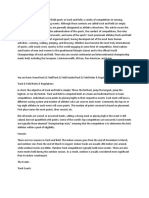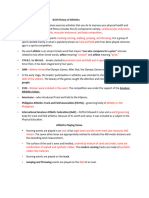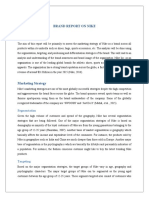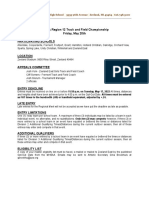0 ratings0% found this document useful (0 votes)
43 viewsWEEK 4 Rules of Track and Field
The document provides rules for various track and field events including running, relay races, hurdling, jumping, and throwing. For running events, a false start results in disqualification. Relay races involve passing a baton between teammates. Hurdling requires jumping over obstacles without knocking them over. The long jump and triple jump are measured from the take-off point to the closest point of landing. Throwing events like javelin, discus and shotput have technical rules around release points and marking boundaries.
Uploaded by
chang.john2004Copyright
© © All Rights Reserved
We take content rights seriously. If you suspect this is your content, claim it here.
Available Formats
Download as PDF, TXT or read online on Scribd
0 ratings0% found this document useful (0 votes)
43 viewsWEEK 4 Rules of Track and Field
The document provides rules for various track and field events including running, relay races, hurdling, jumping, and throwing. For running events, a false start results in disqualification. Relay races involve passing a baton between teammates. Hurdling requires jumping over obstacles without knocking them over. The long jump and triple jump are measured from the take-off point to the closest point of landing. Throwing events like javelin, discus and shotput have technical rules around release points and marking boundaries.
Uploaded by
chang.john2004Copyright
© © All Rights Reserved
We take content rights seriously. If you suspect this is your content, claim it here.
Available Formats
Download as PDF, TXT or read online on Scribd
You are on page 1/ 37
ATHLETICS
Maryrose Gil Ebdani
Instructor 1
Track and Field Arena
Outdoor Track - measures 400m around,
with 84.39m for the straights and
115.611m for the curves
Lanes - divided to 6-8, measures
approximately 1.22m in width
RULES OF TRACK AND FIELD
RUNNING
I. Sprinting is running over a short distance at the top-most
speed of the body in a limited period of time.
● For most elementary to college events, one false start
disqualifies a runner.
● For youth, club, and international events, disqualification
results on the second individual false start
● A false start is called when the athlete moves or leaves the
mark before the gun is shot.
● A starter may not touch on or over the line
before the gun is fired.
● Runners have to stick in their lane.
● The athlete is being timed. Orders of places
are determined when the torso crosses the
finish line.
II. Relay Races- A relay race is an event in which four
participants work as a team to reach the finish line. The
aim is to reach the end as quickly as possible and each
member of the team takes a turn completing part of
the course.
a. The baton must be held in hand the entire race.
b. The runner must not interfere with an opponent
after passing the baton.
c. A baton dropped outside the passing zone must
be retrieved by the runner who dropped it.
e. A baton dropped inside the passing
zone may be retrieved by either runner.
III. Hurdling is the act of jumping over an obstacle at a
high speed or in a sprint
a. The whole body must pass over the hurdle.
b. A hurdler must not cross lane or interfere another
hurdler in another lane/s.
c. The hurdler is not allowed to knock over the hurdles
with the hand or foot intentionally.
JUMPING
I. High Jump
a. The jumper must jump or take off from one foot.
b. Three trials are given in a jumper at each height.
The long jump is a track and field event in which
athletes combine speed, strength and agility in an
attempt to leap as far as possible from a takeoff
point. Along with the triple jump, the two events
that measure jumping for distance as a group are
referred to as the "horizontal jumps".
II. Long Jump
a. A jumper who happens to touch the ground at any point past the
foul line while jumping is considered foul and not measured or
recorded.
b. The jump is measured at right angles to the board and at the point
of landing closest to take off.
III. Triple Jump
a. Triple jump follows the rules set in the
long jump.
THROWING
I. Javelin Throw
a. The javelin shall be held at the grip with one hand only. It shall
be thrown over the shoulder or upper part of the throwing
arm shall not be slung or hurdled.
b. A throw shall be valid only if the metal head strikes the
ground before any other part of the javelin.
II. Discus Throw
a. During the course of throw, the athletes are prohibited from
touching the top of the rim. However, they can touch the inner part
of the rim.
b. An athlete cannot touch the ground beyond the circle.
c. If the athlete leaves the circle before the landing of the disc on the
ground, then it will be considered as a foul throw.
d. There is particular boundary of landing of the
disc. If the disc lands outside that zone then that
throw is considered invalid.
III. Shotput
a. For safety purpose, the players can tape their fingers but they certainly
cannot wear gloves.
b. The resting position of the shot is near the neck and it should remain over
there throughout the motion.
c. With the use of only one hand, the shot should be released above the height
of shoulder.
d. An athlete can use the perimeter of inside the circle but certainly cannot use
the border or outside area of the toe board. Extension of the limbs outside
the circle during the throw is allowed.
e. An athlete should leave the circle from back.
You might also like
- PE LET Individual Dual and Combative Sports With Out TOS67% (3)PE LET Individual Dual and Combative Sports With Out TOS28 pages
- Athletics in Relation To Health Related Fitness HOPEIINo ratings yetAthletics in Relation To Health Related Fitness HOPEII84 pages
- Athletics The Background of Athletics: Track EventsNo ratings yetAthletics The Background of Athletics: Track Events9 pages
- Track and Field Events: Presented By: Banugan, Casey Ticangen, Michelle Galbis, RyanNo ratings yetTrack and Field Events: Presented By: Banugan, Casey Ticangen, Michelle Galbis, Ryan33 pages
- PE-3-TRACK-AND-FIELD-BCC_20241011_192439No ratings yetPE-3-TRACK-AND-FIELD-BCC_20241011_1924393 pages
- Lesson 2.2 Athletics in Relation to HrfNo ratings yetLesson 2.2 Athletics in Relation to Hrf32 pages
- Basic and Battle Physical Training - Jumping, Vaulting, Climbing, Scaling and Obstacle Training - Part VFrom EverandBasic and Battle Physical Training - Jumping, Vaulting, Climbing, Scaling and Obstacle Training - Part VNo ratings yet
- Rules For Track Events: (Based On IAAF Official Handbook)No ratings yetRules For Track Events: (Based On IAAF Official Handbook)35 pages
- See The Sport, Not The Disability Exploring The Paralympic ParadoxNo ratings yetSee The Sport, Not The Disability Exploring The Paralympic Paradox18 pages
- Roscommon Senior & Minor Football Cship Finals 2012No ratings yetRoscommon Senior & Minor Football Cship Finals 201272 pages
- Chubb Bermuda Triangle Challenge Event Programme 2025 FINAL 2No ratings yetChubb Bermuda Triangle Challenge Event Programme 2025 FINAL 2104 pages
- Track and Field Pre-Meet Notes: OfficialsNo ratings yetTrack and Field Pre-Meet Notes: Officials20 pages
- Track and Field Results: Jefferson vs. KentlakeNo ratings yetTrack and Field Results: Jefferson vs. Kentlake11 pages
- Seattle Mariners Minor League Report: Tacoma 3, at Oklahoma City 2No ratings yetSeattle Mariners Minor League Report: Tacoma 3, at Oklahoma City 228 pages







